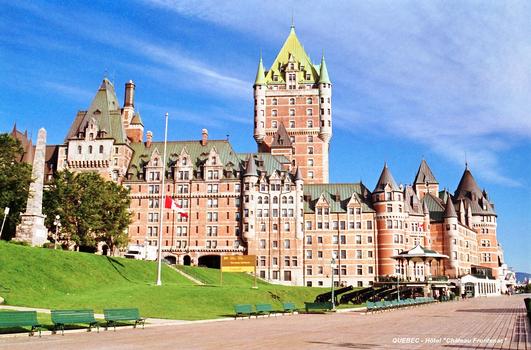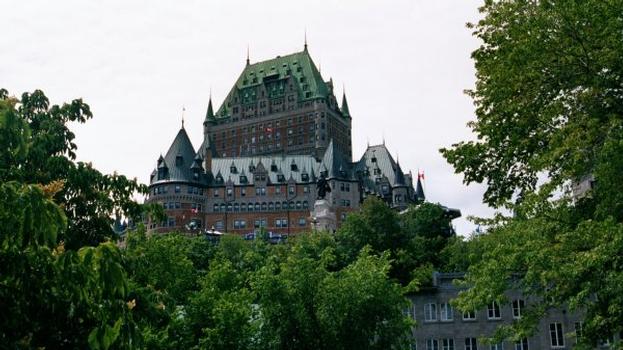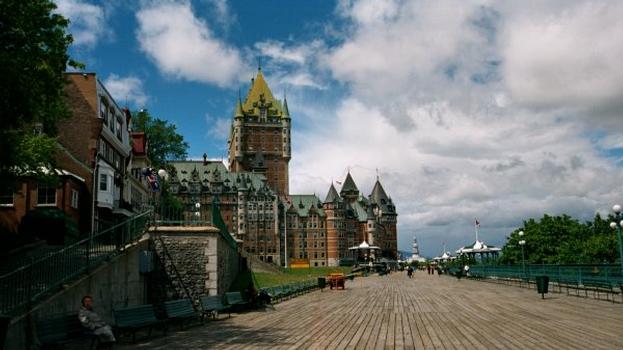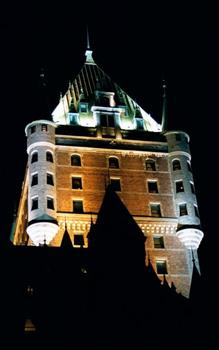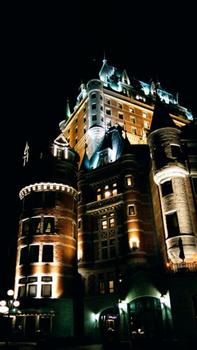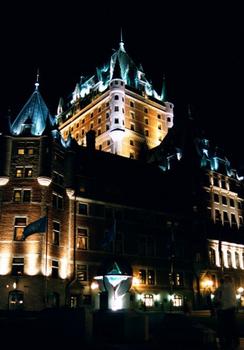General Information
| Completion: | 1893 |
|---|---|
| Status: | in use |
Project Type
| Function / usage: |
Hotel |
|---|---|
| Architectural style: |
Châteauesque |
Awards and Distinctions
| 1981 |
for registered users |
|---|
Location
| Location: |
Quebec, Capitale-Nationale, Quebec, Canada |
|---|---|
| Coordinates: | 46° 48' 42.71" N 71° 12' 19.56" W |
Technical Information
There currently is no technical data available.
Excerpt from Wikipedia
The Fairmont Le Château Frontenac, formerly and commonly referred to as the Château Frontenac, is a historic hotel in Quebec City, Quebec, Canada. The hotel is situated in Old Quebec, within the historic district's Upper Town. The Chateau Frontenac was designed by Bruce Price, and was built by the Canadian Pacific Railway company. The hotel is presently managed by Fairmont Hotels and Resorts.
Opened in 1893, the Châteauesque-styled building is 79.9-metre-tall (262 ft), containing 18 floors. The building's height is furthered, as it is situated at an elevation of 54 m (177 ft). It is one of the first completed grand railway hotels. The hotel was expanded on three occasions, with the last major expansion taking place in 1993. The building was designated a National Historic Site of Canada in 1981.
Location
The Château Frontenac is situated on 1, rue des Carrières, at the eastern edge of Old Quebec's Upper Town, built on the promontory of Quebec, a raised mass of land that projects into the Saint Lawrence River. The hotel property is bounded by rue Saint Louis to the north, and rue Mont Carmel to the south. Terrasse Dufferin is a terrace that wraps around the hotel from the northeast to the southeast, overlooking the Saint Lawrence River. Two public roads run through the hotel, rue du Trésor, and rue des Carrières. The hotel building was designated as a National Historic Site of Canada, known as the Château Frontenac National Historic Site of Canada. The area was designated as a National Historic Site in January 1981.
Located near the edge of the promontory of Quebec, the Château Frontenac is situated near several major historic attractions within the historic district of Old Quebec's Upper Town. To the northeast of the hotel lies the Ursulines Monastery of Quebec, a 17th century monastery founded by a missionary group of Ursuline nuns, and another National Historic Site of Canada. To the south of the hotel lies the Plains of Abraham, a historic area within The Battlefields Park, and the site of the Battle of the Plains of Abraham. Another major attraction south of the hotel is the Citadelle of Quebec, situated at the atop Cap Diamant, an elevated point of the promontory. The Citadelle serves as an active military installation for the Canadian Armed Forces, as well as a secondary official residence for the Canadian monarch and the Governor General of Canada. East of the hotel lies the Terrasse Dufferin, and Old Quebec's Lower Town directly below it.
The Château Frontenac was not the first hotel built on the site. The first hotel was built during the 1780s, and was known as the Château Haldimand, named after the Governor of Quebec who ordered the hotel's construction. That hotel was later demolished to make way for the present hotel.
Design
Architecture
Designed in a Châteauesque style, the building features steep pitched roofs, circular and polygonal towers, and ornate gables and dormers.
The Château Frontenac is one of Canada's grand railway hotels built by the Canadian Pacific Railway. The Châteauesque architectural style used throughout the hotel would later serve as a template for other Canadian grand railway hotels erected in the late-19th to early-20th century. The central fortress-like tower design is derived from medieval chateaus found throughout France's Loire Valley. Châteauesque elements include the hotel's asymmetrical profile, with steeply pitched roofs, massive circular and polygonal towers and turrets, ornate gables and dormers, and tall chimneys. The exterior base of the hotel is largely made of grey stone ashlar, with steel framing running up the building, Glenboig brick cladding. Materials that make up the interior of the building includes mahogany panelling, marble staircases, carved stone, wrought iron, and glass roundels. However, as opposed the other Châteauesque-styled buildings found in France, the Château Frontenac did not utilize elements of Italianate architecture, instead placing a greater emphasis on Gothic elements. The hotel also draws certain elements from Victorian style of architecture, with rich polychromatic surfaces throughout ist exterior.
Built in 1892–93, the Château Frontenac was originally designed by architect Bruce Price. Price's plan called for a horseshoe-shaped hotel, made up of four wings of unequal length, connected at obtuse angles. Public rooms made up the majority of the first two floors of Price's designs. The original proposal called for a square structure, however the completion of the Terrasse Dufferin led to the development for a more picturesque building. Since ist completion, the hotel has undergone several major expansions and renovations led by several different architects and architectural firms. William Sutherland Maxwell led two major expansions to the hotel, one in 1908–09, and another in 1920–24 (co-led with his brother, Edward Maxwell). Renovations in the 1990s was led by the Arcop, a architectural firm based in Montreal. The hotel was again expanded in 1993, with the addition of a new wing.
Several porte-cochères provide access to the hotel's central courtyard.
Access to the hotel's main entrance is marked by several porte-cochère with large dormers and a cupola. The porte-cochère leads guests into the hotel's centre courtyard, as well as the entrance to the hotel's main lobby. The building stands 80-metre-tall (260 ft), containing 18 floors primarily made up of guest rooms and other hotel amenities. After the addition of the tallest tower in 1924, the hotel became the tallest building in Quebec City. It remained the city's tallest building until 1930, when Édifice Price was completed just northeast of the hotel. Although several buildings in Quebec City are taller, the hotel continues to hold a prominent position in the city's skyline, as it is perched atop a tall cape overlooking the Saint Lawrence River.
Facilities
The Château Frontenac includes 611 guest rooms and suites spread throughout the hotel building. Eight executive suites were renovated into specialty "themed rooms". Most of the suites are themed to the heads of state and government that have visited the hotel, such as the Trudeau-Trudeau Suite, named after two Canadian Prime Ministers, Pierre Elliott Trudeau, and Justin Trudeau. The Churchill Suite, and Roosevelt Suite are two suites named attendees of the First and Second Quebec Conference, British Prime Minister Winston Churchill, and the American President Franklin D. Roosevelt respectively. Other suites themed in honour of world leaders include the Charles de Gaulle, the President of France, and Elizabeth II, the Queen of Canada.
Aside from world leaders, the hotel also offers suites themed to Alfred Hitchcock, a director who filmed much of I Confess at the hotel, and William Cornelius Van Horne, the second President of Canadian Pacific Railway, and Celine Dion. The Celine Dion Heritage Suite utilizes an Art Deco style throughout the suite, decorated with images from Dion's family photographer.
A number of rooms at the Château Frontenac are also occupied by restaurants, and other food-based services. As of 2018, three restaurants operate within the hotel, 1608 Wine and Cheese Bar, Bistro Le Sam, and Champlain. As a part of Fairmont Hotels and Resorts larger "Bee Sustainable" program, the Château Frontenac hosts four queen honey bees in hives on the hotel's rooftop garden. The honey is harvested three times a year, and is used by the hotel's restaurants. The hotel has nearly 70,000 honey bees producing 295 kilograms (650 lb) of honey per year. The hotel's rooftop apiary also operates a pollinator hotel.
History
Portrait of Louis de Buade de Frontenac at the hotel lobby. The hotel was named after the former Governor General of New France.
Pre-construction 1800s
In the 1870s, a restoration project began in Quebec under the British governor general of Canada aimed at restoring the capital to ist former 17th century look. One of the contributors to this project was Lord Dufferin, who supervised the construction of the old city wall and many public buildings that followed the theme of old, medieval, European Quebec. Dufferin also made a plan to reconstruct the Chateau Saint-Louis which was located on the cape where the Chateau Frontenac currently stands and served as the home of the French governors from 1620 to 1834. Dufferin's plan did not take off until the City Council and the Board of Trade adopted the idea and planned to instead construct a grand hotel on the site to attract upper-class tourism to the area, but after failing to finance ist construction, businessmen from Toronto and Montreal with connections to the Canadian Pacific Railway took control of the project.
1900s-present
The Château Frontenac was completed in 1893, and was designed by American architect Bruce Price and overseen by William Van Horne, the Canadian Pacific Railway's general manager and a key developer of the Canadian railway hotel system. The hotel was a part of a series of Chateauesque-styled hotels built for the Canadian Pacific Railway company during the late 19th and early 20th centuries. The last of the Canadian Pacific Railway's Chateauesque hotels was completed in 1908, leaving the rival company Grand Trunk Railway to continue the trend. The hotel was expanded in 1924 to designs by William Sutherland Maxwell. The 1924 expansion saw the addition of the hotel's central tower. The hotel was named after Louis de Buade, Count of Frontenac, who was the Governor General of New France from 1672 to 1682, and again from 1689 to 1698.
Reception for the Second Quebec Conference, at the Château Frontenac. The allies of World War II met there twice during the war.
The World War II Allies' met during the First and Second Quebec Conference (in 1943 and 1944 respectively). During these conferences, officials including American President Franklin Delano Roosevelt, British Prime Minister Winston Churchill, and Canadian Prime Minister William Lyon Mackenzie King, discussed strategy for World War II.
In 1953, this hotel was used as the filming location for the final scene in Alfred Hitchcock's film I Confess, featuring Montgomery Clift and Anne Baxter.
In 1993, the hotel saw another expansion, with the addition of the new wing that included a pool, fitness centre, and outdoor terrace. On June 14, 1993, Canada Post issued 'Le Château Frontenac, Québec' designed by Kosta Tsetsekas, based on illustrations by Heather Price. The $C0.43 stamp features an image of the hotel building, and are perforated 13.5 and printed by Ashton-Potter Limited.
In 2001, the hotel was sold to Legacy REIT, which is partially owned by Fairmont, for $185 million. The hotel was renamed the Fairmont Le Château Frontenac in November 2001, shortly after Canadian Pacific Hotels reformed itself as Fairmont Hotels and Resorts, taking the name of an American company it acquired in 2001.
From 2011–12, when the hotel's copper roof was being replaced, an image of the roof was printed on safety netting and hung from scaffolding in order to hide the refurbishment work.
In 2011, the hotel was sold to Ivanhoé Cambridge. Shortly after acquiring the hotel, Ivanhoé Cambridge announced an investment of $9 million for the restoration of the building's masonry work, and to replacement of the building's copper roofs. The company further announced another $66 million investment for general improvements and renovations throughout the hotel. When the roof was being replaced, an image of the roof was printed on polypropylene safety netting and hung from scaffolding to hide the refurbishing project from view. The extensive renovation saw conference rooms expanded, restaurants remodeled, modernization of the lobby, and the gutting and rebuilding of three-fifths of the hotel's rooms.
The hotel was featured in the 2016 Korean drama Guardian: The Lonely and Great God.
Text imported from Wikipedia article "Château Frontenac" and modified on July 22, 2019 according to the CC-BY-SA 4.0 International license.
Participants
- Bruce Price (architect)
Relevant Web Sites
- About this
data sheet - Structure-ID
20004272 - Published on:
15/07/2002 - Last updated on:
25/10/2015

